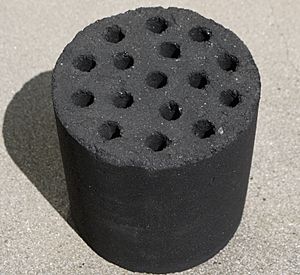Yeontan facts for kids
Quick facts for kids Yeontan |
|||||||||
|---|---|---|---|---|---|---|---|---|---|
 |
|||||||||
| Chinese name | |||||||||
| Traditional Chinese | 蜂窩煤 | ||||||||
| Simplified Chinese | 蜂窝煤 | ||||||||
|
|||||||||
| Korean name | |||||||||
| Hangul | 연탄 | ||||||||
| Hanja | 練炭 | ||||||||
|
|||||||||
| North Korean name | |||||||||
| Chosŏn'gŭl | 련탄 | ||||||||
| Japanese name | |||||||||
| Kanji | 煉炭/練炭 | ||||||||
| Kana | れんたん | ||||||||
|
|||||||||
Yeontan (Korean: 연탄) are special coal briquettes. People in East Asia use them for cooking and to heat their homes. They are made from a mix of lignite coal dust and a special glue. This glue holds the dust together.
Yeontan briquettes were a good choice instead of firewood or natural coal. This is because they always came in the same size and shape. This made them easy to stack and use.
There are five common sizes for yeontan. The second standard size is the most popular for homes. This briquette is shaped like a cylinder. It weighs about 3.5 kilograms. It is also about 20 centimeters tall and 15 centimeters wide.
Each standard yeontan has 22 holes on top. These holes help the briquette burn steadily and well. A family usually used one to three briquettes each day in winter. Sometimes, a new yeontan was placed on top of one that was half-burned. This helped keep the fire going all the time.
Heating Homes with Ondol
The same fire used for cooking also helped heat the house. This was done using a special Korean heating system. It is called ondol. Ondol is a radiant underfloor heating system. This means the heat travels through the floor to warm the room.
See also
 In Spanish: Yeontan para niños
In Spanish: Yeontan para niños

